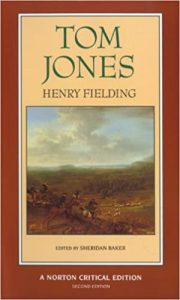When I was very young, perhaps five or so, I remember that one of the major milestones in reading was starting to tackle “chapter books”: books divided into chapters. A “chapter book” might still be a book for children, but it was longer and more complex than chapterless fare like The Cat in the Hat. Here things started to get interesting: these were books that could last more than one sitting, with space enough for real plots and characters. In short, chapter books felt like “real” books––they might not even have pictures!
But have books always had chapters? Literary critic Nicholas Dames, working on a history of the chapter, writes that the practice of breaking up texts into manageable chunks goes back at least to the ancient Romans. Latin treatises on farming and history had divisions called capitula (where we get the word chapter) that would allow a reader to go back and find the specific section they might need. In the early centuries of Christianity, the Bible was divided into chapters for that purpose as well––though it took until the 13th century for one set of chapter divisions to become standard, the one we still use today. (If you held up “John 3:16” at a baseball game back in the Byzantine Empire, only people with the same edition would know which verse you meant!)
When novels, or fictional narratives in prose, first emerged in Europe in the seventeenth and eighteenth centuries, it wasn’t clear whether they were the sorts of books that ought to have chapters or not. Practically all of the candidates for “first novel” employ a different internal method of organization, or none at all: Don Quixote (Spain, 1605) was divided into chapters, but La Princesse de Clèves (France, 1678) has just a few long “parts,” as does Eliza Haywood’s Love in Excess (England, 1719); Aphra Behn’s Oroonoko (England, 1688) is too short to need chapters, while Daniel Defoe’s Robinson Crusoe (England, 1719) is long enough that perhaps it *should* have chapters but nonetheless plows straight ahead, browbeating the reader with a wall of uninterrupted text.
 All this leads up to arguably the first novelist to truly have fun with chapters: Henry Fielding. Fielding was familiar with Don Quixote and borrowed the division into chapters for his novel Tom Jones (1749), and each chapter came with a short description of what it contained. Fielding describes these descriptions as the “Bill of Fare,” or menu, at the very beginning of the novel. [A side note: Tom Jones is proof that you should never write while hungry; as the great 1963 film adaptation demonstrates, it’s one of the hungriest (and thirstiest) novels ever composed.] Inns and taverns, Fielding observes, “provide a bill of fare which all persons may peruse at their first entrance into the house; and having thence acquainted themselves with the entertainment which they may expect, may either stay and regale with what is provided for them, or may depart to some other ordinary better accommodated to their taste.” Following their example, Fielding writes, he has provided “particular bills to every course,” or chapter, “which is to be served up in this and the ensuing volumes.” This way the reader can be prepared for what will come in each chapter, although Fielding is also wary of giving too much away ahead of time; a little curiosity, after all, piques the appetite.
All this leads up to arguably the first novelist to truly have fun with chapters: Henry Fielding. Fielding was familiar with Don Quixote and borrowed the division into chapters for his novel Tom Jones (1749), and each chapter came with a short description of what it contained. Fielding describes these descriptions as the “Bill of Fare,” or menu, at the very beginning of the novel. [A side note: Tom Jones is proof that you should never write while hungry; as the great 1963 film adaptation demonstrates, it’s one of the hungriest (and thirstiest) novels ever composed.] Inns and taverns, Fielding observes, “provide a bill of fare which all persons may peruse at their first entrance into the house; and having thence acquainted themselves with the entertainment which they may expect, may either stay and regale with what is provided for them, or may depart to some other ordinary better accommodated to their taste.” Following their example, Fielding writes, he has provided “particular bills to every course,” or chapter, “which is to be served up in this and the ensuing volumes.” This way the reader can be prepared for what will come in each chapter, although Fielding is also wary of giving too much away ahead of time; a little curiosity, after all, piques the appetite.
Some of these “particular bills” for each chapter or “course” are straightforward (“In Which Mr. Western Visits Mr. Allworthy,”) some are coy (“A Very Long Chapter, Containing a Very Great Incident”), and some are downright silly (“Containing Such Grave Matter, That the Reader Cannot Laugh Once Through the Whole Chapter, Unless Peradventure He Should Laugh at the Author”). My favorite, though, is Book IV Chapter 1: “Containing Five Pages of Paper.” It’s a sort of joke on the chapter itself, as a unit of narrative meaning that’s also part of a physical object. A chapter can be said to “contain” both a pivotal episode and a certain amount of paper and glue, albeit in different ways; Fielding’s joke yanks us out of the fictional world in our heads to remind us of the material thing in our hands.